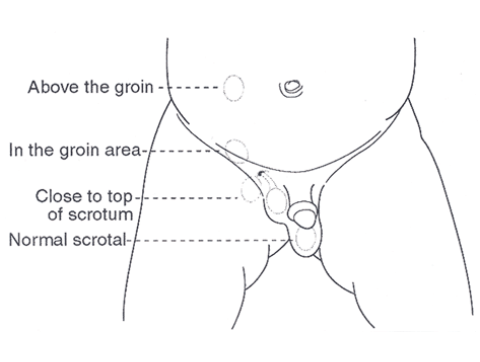Cryptorchidism (UDT, Undescended Testes)
What is cryptorchidism?
Cryptorchidism means hidden testicles. Testes (or testicles) are the male reproductive glands. They make sperm and testosterone. Most often, the testes move from inside the body to the scrotum before a baby boy is born. Cryptorchidism, or undescended testes (UDT), happens when something stops a normal testicle descent. So, the testes do not move all the way down to the scrotum.
What are the causes?
There are several known factors. Sometimes, in premature babies, there is not enough time for the testes to move from the abdomen to the scrotum. Sometimes, there are not enough of certain hormones (called androgens) before a baby is born. Other times, there is not enough pressure in the abdomen to move the testes down into the scrotum. UDT can also be a part of certain syndromes. At times, the cause is unknown.
How common is it?
UDT is common (see table). It is even more common in premature infants. This happens because the testes normally finish their descent during the last 3 months of pregnancy. So, the testes of premature babies often have not had time to travel down into the scrotum. As boys get older, the chances of having UDT are less. This happens because most undescended testes move down by themselves (without treatment) in the first year of life. In fact, in most cases, they move down within the first few months. If the testes have not moved down in the first year, treatment is needed.
| Age | Effect of Age on Frequency of UDT |
|---|---|
| Premature, under 2 pounds | 50-60% |
| Premature, up to 5 pounds | 20-30% |
| Term infants | 2-4% |
| One year old | 0.5-1% |
| Young adults | under 1% |
UDT involves both testes (two-sided) in 10-30% of cases. When it involves only one testis, it is more often the right one.
Where can undescended testes (UDT) be found?
Testes that are not in the scrotum can be found in different places in the body (see picture below). They may be in the abdomen, the groin, or the side of the scrotum. In some areas of the body, the testes are difficult to feel during a physical exam.
Some testes enter and leave the scrotum intermittently. This is usually due to an overactive muscle and poor attachment to the scrotum. This is a common occurrence from ages 3 months to 7 years and are often called "retractile testes." Often both testes are involved. After puberty these testes normally stay in the scrotum and are normal in size and function. They should be followed closely.

What are the risks?
A testis outside the scrotum does not develop normally. When outside the scrotum, the body temperature is higher and the testes cannot move as easily. This interferes with the function, structure and safety of the testes.
- Infertility: Infertility is a risk in untreated one-side UDT and especially two-sided UDT. Testes in the groin and above are more likely to cause infertility. Infertility risks are lowered if the testicle(s) are brought into the scrotum before the ages of 1-2 years.
- Cancer: The UDT has about 10-40 times the risk of developing testicular cancer. Still, the risk is only about 1 tumor per 2000 undescended testicles. About 10% of men with testicular cancer have a history of UDT. Testes found above the groin have a higher risk of developing cancer.
- Injury: Testes in the groin that cannot move freely are more susceptible to injury.
Contact us to request an appointment or ask a question. We're here for you.




